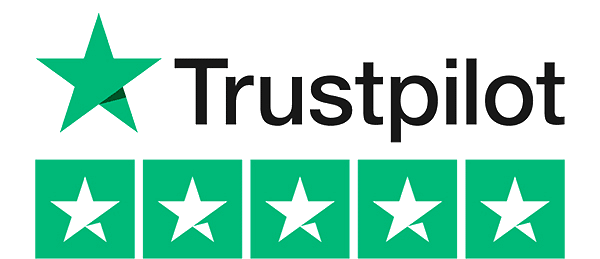What is 'Brand Asset Management'?
It's how you manage your brand's assets! Brand Asset Management (BAM) centralises, organises, and safeguards the digital assets that define your brand - logos, templates, imagery, and guidelines - ensuring consistency, efficiency, and compliance.
Without BAM, teams can waste up to 30% of their time searching for or recreating files, leading to costly duplication and off-brand mistakes.
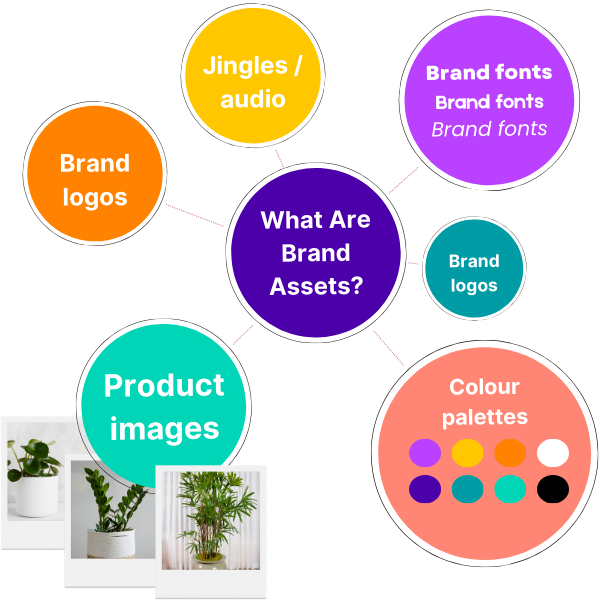
According to industry surveys, creatives and marketers spend nearly a third of their time just looking for files. That’s hours every week lost to hunting down the right logo, re-creating templates from scratch, or scrolling through inboxes for that “final_final_FINAL” campaign visual.
As your brand grows, things can get messy fast.
Staying on top of the right versions, keeping content consistent, and making sure everyone has access? That quickly turns into a full-time juggling act.
That’s where Brand Asset Management steps in – your shortcut to a more organised, consistent brand.
-3.png?width=1920&height=1080&name=Untitled%20design%20(1)-3.png)
-3.png?width=960&height=540&name=Untitled%20design%20(4)-3.png)
Think of it as your brand’s one-stop shop. A central hub where all your digital files live – logos, templates, product shots, campaign visuals – all neatly organised, always up-to-date, and ready to share.
Whether you're launching a new product or rolling out a rebrand, brand management software makes sure everyone has the right asset at the right time.
From global marketing teams to small in-house comms squads – even freelance brand managers – a digital brand asset management system keeps everything (and everyone) in sync.
No more duplicates, no more guesswork – just one smart, cloud-based place to find what you need, fast.
We’ll show you how the best brand asset management solutions and digital asset management for brands can transform your workflows and increase the return on your creative investments. You’ll learn:
- What is Brand Asset Management Software?
- BAM vs DAM
- How BAM Powers Your Brand
- The Benefits of Brand Asset Management
- Who Uses Brand Asset Management?
- Video: 5 Best Practice Tips for BAM
- Case Study – Amnesty International
- Frequently Asked Questions about BAM
Let’s begin by unpacking exactly what brand asset management software is – and why it's such a vital part of your brand’s success.
-1.png?width=960&height=540&name=Untitled%20design%20(5)-1.png)
.png?width=450&height=450&name=Brand%20Asset%20Management%202%20(4).png)
Brand asset management (BAM) is the process of storing, organising, and managing all the visual and written content that represents your brand. That includes everything from logos and campaign visuals to brand guidelines, product imagery, and messaging templates.
A brand asset management system is the software that helps you manage everything that represents your brand.
It's the central hub, where every digital asset is easy to find, all assets are properly tagged, and used in the right context – no more duplicates, no outdated files, and no brand inconsistencies.
It’s a must-have for any team managing content across departments, markets, or agencies.
Whether you're a designer, a marketer, or a salesperson, BAM ensures that everyone – from in-house teams to freelancers – is working from the same, approved version of every piece of content.
Examples of Brand Assets
Brand assets include any content that represents your brand visually or verbally. This can include:
- Logos (and variations by colour, size, format)
- Brand guidelines and tone of voice documents
- Campaign visuals and templates
- Product and lifestyle imagery
- Icons, fonts, and graphic elements
- Social media content and ad creatives
- Presentation decks and brochures
- Messaging templates or boilerplate copy
All these assets shape your brand – so they need to be easy to find and ready-to-use. Without a central hub, these pieces of content can quickly get buried in old folders, or duplicated again and again… leading to confusion, delays, and off‑brand mishaps.
.png?width=450&height=450&name=Brand%20Asset%20Management%202%20(11).png)
Brand asset management (BAM) is a specialised part of the wider DAM world. While digital asset management looks after all your digital files, brand asset management zeroes in on the content that defines your brand – the logos, images, templates, and tone-of-voice guides that shape how people see (and remember) you.
A strong brand asset system keeps your brand identity front and centre, across every channel and campaign. It gives your team quick access to the right content, protects against off-brand mishaps, and helps you stay on the right side of legal and compliance guidelines. It’s how top brands stay consistent, confident, and ready for anything.
The best brand asset management tools don’t just store your files – they give you structure, clarity, and control. Everyone knows what they can use, where to find it, and how to use it properly.
So you can stop worrying about brand slip-ups and start showing up brilliantly, every time.
When these assets are stored in DAM software, the system's intuitive search functionality and meta-tagging makes them easier than ever for anyone to find.
Can DAM Software Also be BAM Software?
Yes! Many digital asset management systems (like Asset Bank) include brand-focused functionality.
Think of digital asset management as the practice of managing all your digital files. BAM refers only to the specific brand elements. (There's a lot of overlap!)
Further still, is Media Asset Management (MAM), which refers to media file management only, i.e., video files, audio, podcasts, music files, etc. We won't go into that too much here, but we've got a whole blog on DAM vs MAM that you can explore. Generally, MAMs are more specific, and more suited to clients who are specifically managing music files and video/audio recordings.
A digital asset management platform for brands looks after all three – managing complex file libraries while also ensuring your brand assets are protected and easy to use.
.png?width=450&height=450&name=Brand%20Asset%20Management%202%20(15).png)
A good DAM system offers practical yet powerful AI-enhanced features for managing your assets, such as:
- AI Auto tagging, so assets are easy to search: Each file gets labelled with helpful info (like what it’s for, when it was used, or which campaign it belongs to), so you can quickly find what you need.
- Natural language & AI search: Describe what you’re looking for in plain language – even in French, German, or Spanish – and let AI find the perfect match from your DAM.
- Version control: You’ll always be working with the most up-to-date, approved file – with older versions saved, just in case you need them.
- Permission-based access: Different people see different things, depending on their role. Your brand manager might see everything, while a salesperson only sees the files they need.
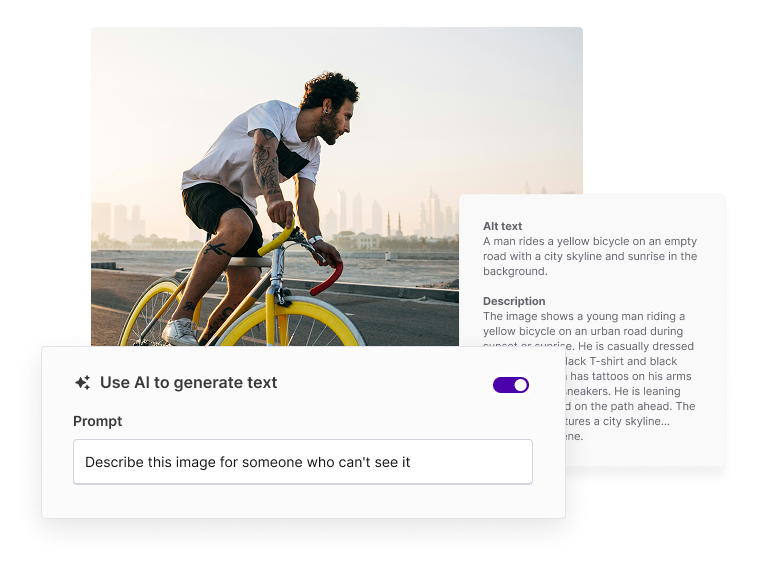
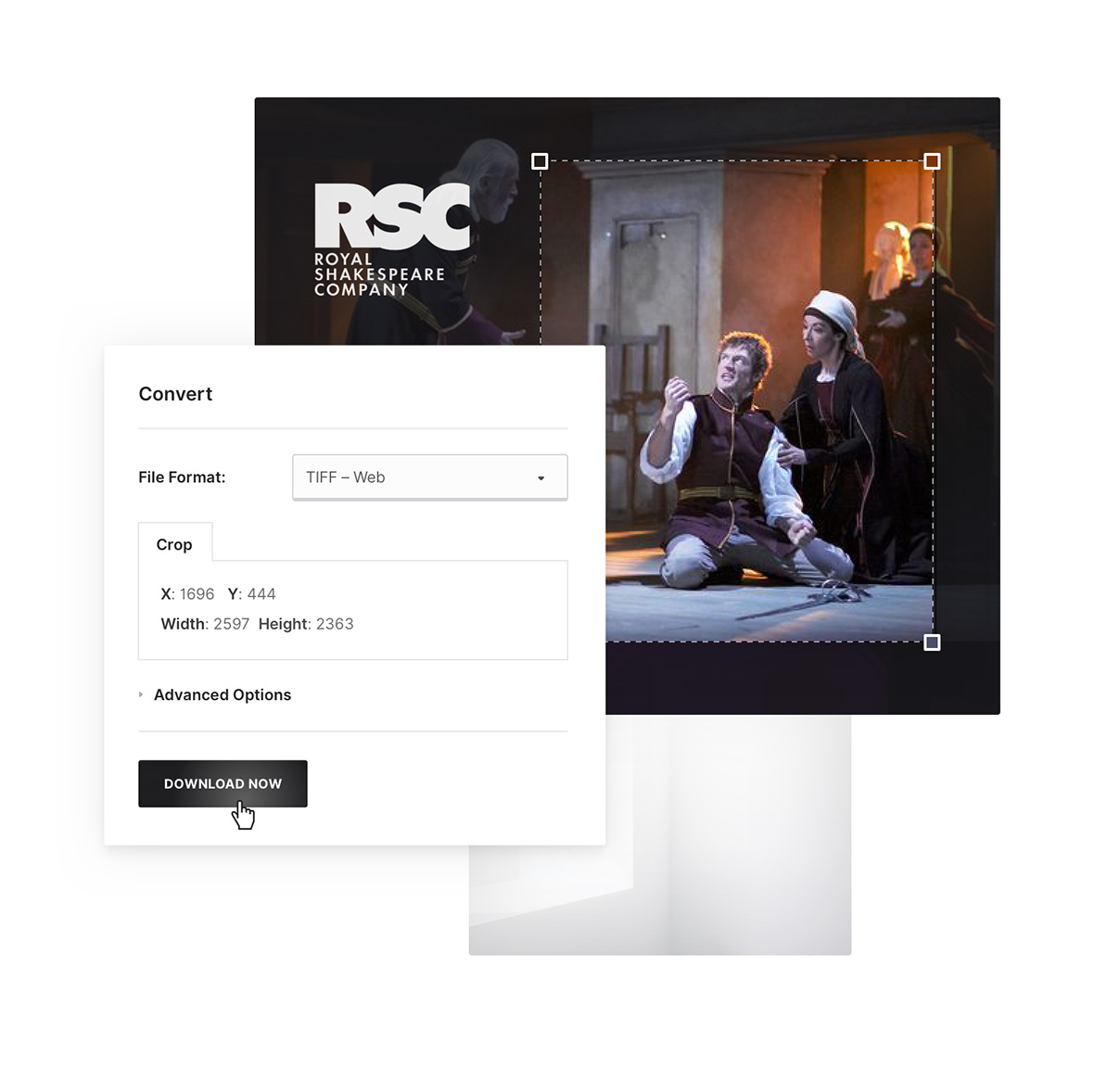
- Previews & download options: Check what a file looks like and choose the best format for web, print, or social – all in one place.
- Audit trails & expiry dates: You’ll know who used what and when, and the system can flag or hide outdated content so it’s not accidentally reused.
- Integrations with your favourite tools: Asset Bank connects easily with Adobe Creative Cloud, SharePoint, WordPress, and more – so your team can find and use brand files without switching systems.
In short, a DAM platform makes your brand asset management ultra efficient, transparent, and accessible.
One Place Where Everything Lives
The key feature of any brand asset management system is its central library. Instead of assets being scattered across email chains, cloud folders, or individual desktops, a brand asset management platform stores everything in one secure location.
For example, with Asset Bank, files are uploaded, tagged and sorted into clearly defined folders – mirroring the way your teams naturally work. This means:
- No more duplications or outdated versions floating around
- Everyone works from the same, approved set of assets
- New team members or partners can onboard quickly and independently
With a logical folder structure and intuitive interface, even non-technical users can find what they need in seconds.
.png?width=600&height=600&name=Brand%20Asset%20Management%202%20(16).png)
.png?width=450&height=450&name=All%20AI%20Features%20Images%20(4).png)
AI-Powered BAM for Even Smarter Search Results
Search isn’t just about keywords anymore. Asset Bank’s smart search features use AI to go beyond simple tags and keywords:
- AI Visual Search: Just type what you’re looking for in plain language (even in French, German, or Spanish), and let AI do the searching – no tags, filenames, or guesswork needed.
- AI Similar Image search: Find images that look alike (useful for campaigns or product collections)
- AI Search by Image: Drag and drop an image into the search bar to find the original version of an edited piece.
This speeds up workflows and encourages asset reuse.
Important Information Attached to Every Image
In Asset Bank, every asset can be tagged with helpful info (metadata) like file type, the title and description, the name of the campaign it's attributed to, usage rights, language, and expiry dates.
Better still, AI does a load of it for you! Rather than manually typing out alt text and descriptions for images when you upload them, AI generates it instead! All you have to do is review!
Plus, AI-assisted tagging, automatically recommends tags based on the image content or file context. The result? A powerful search experience that allows users to filter by keyword, content, colour, date, size, asset type, and more.
-1.png?width=450&height=450&name=All%20AI%20Features%20Images%20(16)-1.png)
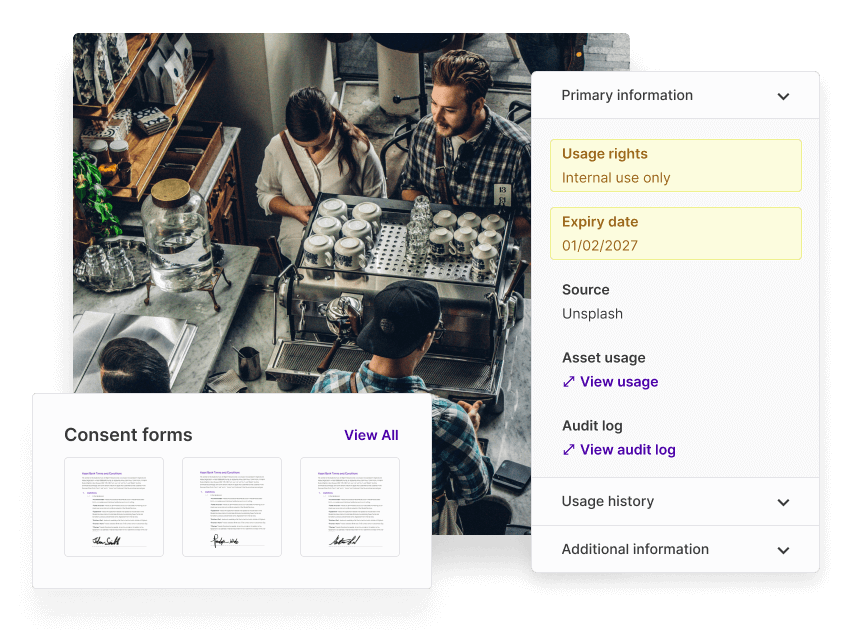
Everyone Knows What’s New, What’s Old, and What’s Expired
Set expiry dates for your assets, so outdated content is automatically archived or flagged for review.
If a user has previously downloaded an asset that has since been updated, or has reached its expiry date, that user will receive an automatic email notification telling them to take action.
BAM Software Integrates With Your Existing Systems
Your brand assets should be easy to find wherever your team is working. That’s why Asset Bank connects smoothly with the tools you already use, like:
- Adobe Creative Cloud (Photoshop, InDesign, Illustrator)
- Canva
- Google Drive
- Microsoft SharePoint and Office 365
- CMS platforms like WordPress and SiteCore
No more switching between systems or downloading and re-uploading elsewhere – your team can access the right files directly from the tools they’re working in.
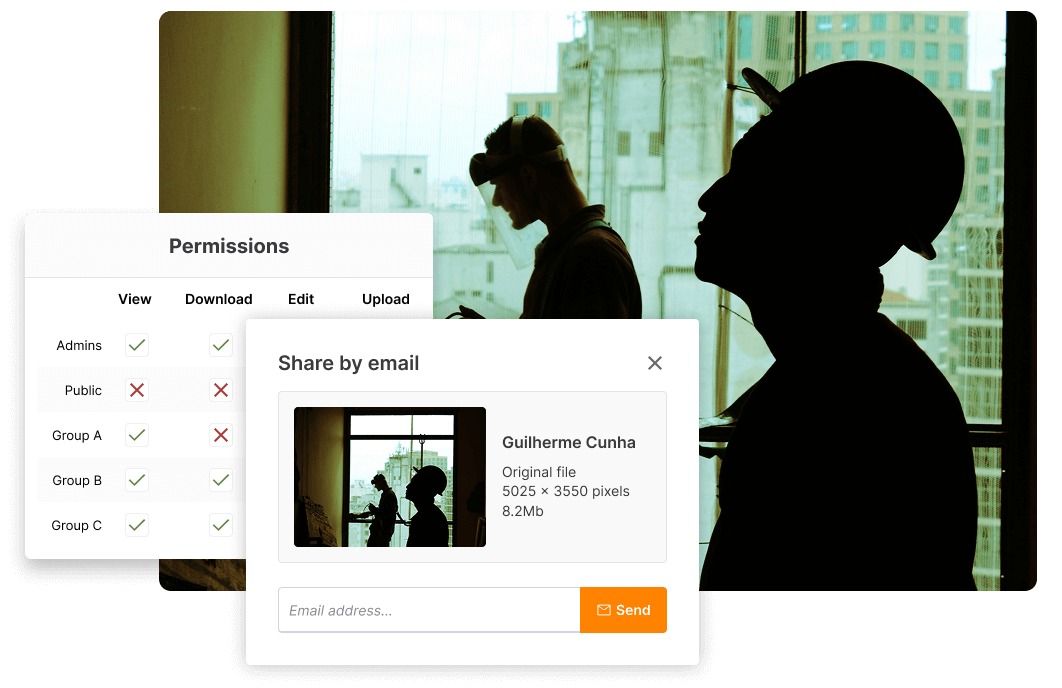
Faster Time-To-Market & Cost Savings
One of the most immediate benefits of brand asset management is the reduction in time spent searching for content.
With a platform like Asset Bank, everything is logically organised, intelligently tagged, and easily searchable. That alone can save:
- 20–30% of time per user every week
- £1,000s in unnecessary duplication – for example, organisations often discover they’ve purchased the same stock images multiple times.
By eliminating these inefficiencies, BAM doesn’t just speed things up – it directly improves ROI on your content investments.
.png?width=450&height=450&name=Brand%20Asset%20Management%202%20(19).png)
.png?width=600&height=600&name=Brand%20Control%20600%20x%20600px%20(3).png)
Stronger Brand Consistency & Compliance
When brand assets are scattered across different systems (or worse, hidden in email threads), brand consistency suffers. Wrong logos get used. Outdated templates reappear. And off-brand messaging creeps in.
Brand asset management fixes this by ensuring that only approved, up-to-date assets are available to users. With version control and access permissions, teams can confidently use assets knowing they’re on-brand and compliant.
This is especially critical for:
- Maintaining a cohesive brand identity across channels and regions
- Regulatory compliance, especially for industries like healthcare, finance or non-profits
- Ensuring campaign assets are used correctly and retired on time
Improved Productivity & Collaboration Across Teams
When content is easy to find, everything moves faster. Campaigns get launched sooner, sales decks are created in minutes, and collaboration becomes seamless.
Cross-departmental teams, or teams in different time zones, can work together without bottlenecks or delays thanks to:
- Real-time asset previews and approvals
- Lightboxes and shared collections for projects
- Integrated creative workflows with platforms like Canva, Adobe and SharePoint
.png?width=450&height=450&name=Brand%20Asset%20Management%202%20(21).png)
.png?width=450&height=450&name=Brand%20Asset%20Management%202%20(23).png)
Security & Rights Management For Protected Brand Assets
Brand content is valuable – and often sensitive. BAM platforms like Asset Bank include robust security features designed to protect your assets at every level. Key features include:
- Encryption and SSO (Single Sign–On) for secure user authentication
- Role–based permissions to control access across departments and partners
- Usage rights tracking to ensure assets are used only within licensed terms
- Watermarking and expiry settings to protect and manage file lifecycles
Whether you’re working with internal teams or external collaborators, you can share assets confidently and securely.
Data-Driven Insights on Asset Usage
Beyond storage and access, modern brand asset management platforms offer valuable analytics. These insights help you understand:
- Which assets are being used the most (and by whom)
- How often assets are downloaded or shared
- Where duplicates exist across your content library
With this data, teams can make smarter decisions about what to create, what to retire, and how to improve future campaigns.
Brand asset management delivers impact at every level – saving time, safeguarding brand identity, and helping you get more from your content investments.
.png?width=450&height=450&name=DAM%20Reporting%20600%20x%20600px%20(1).png)
Who Uses Brand Asset Management – and How?
Internal & External Teams
Brand asset management platforms, like Asset Bank, are used daily by:
- Marketing teams use it to roll out campaigns at speed, and stay consistent across channels.
- Designers use it to find the latest templates, avoid rework, and streamline feedback.
- Sales teams use it to quickly access the right visuals for pitch decks.
- PR teams use the secure sharing portals to serve assets, product or event imagery to press partners
- Legal and compliance teams use it to manage rights, track usage, and stay audit-ready. (Read about the legal risks of mismanaging your content.)
- Agencies and partners use it to get self-serve access to brand-approved assets.
- Freelance photographers or designers upload their content for approval before it's set live
If you’ve got a brand to protect and share, you’ll benefit from BAM. In short: if your team touches content, they’ll benefit from a better way to manage it.
How is the BAM software used?
For companies that work with external creatives, agencies or freelance contributors, Asset Bank’s features like portals, guest access, and lightboxes are game changers.
- Portals allow photographers or designers to submit assets directly into the system.
- Guest access lets collaborators view or download only the assets they need.
- Lightboxes enable users to group and share collections of assets for specific projects.
This ensures seamless collaboration while keeping full control over what’s shared, how it’s accessed, and who can see it.
With clear permissions, custom user roles and brand portals, good brand asset management helps these teams collaborate efficiently – internally and externally – without compromising brand standards.

Customer Testimonial: Amnesty International
For global organisations like Amnesty International, brand asset management is about more than efficiency – it’s about integrity. With campaign materials being created, shared and repurposed by teams around the world, they needed a solution that ensured everyone was using the right content.
Asset Bank helps Amnesty manage a wide variety of digital assets – videos, social graphics, reports and photography – while maintaining control over brand usage, image rights, and access permissions. Their brand asset management supports real-time global collaboration, without compromising security or consistency.
Conclusion: Take Control of Your Brand Assets with Brand Asset Management
The way you manage your brand assets can make or break your marketing effectiveness. A structured approach to brand asset management (BAM) – backed by the right technology – empowers organisations to work smarter, protect their brand identity, and unlock measurable returns.
By centralising your assets, you eliminate silos and reduce time spent searching for files. Through consistent governance and permissions, you maintain brand integrity across every channel. And with smart metadata, AI-powered search, and analytics, you gain the insights needed to improve workflows and increase asset reuse.
Asset Bank brings all of this together in a powerful yet user-friendly platform designed specifically for brands, marketers, and content teams. With its intuitive UI, branded portals, rich integrations, and proven results for clients like WIEHAG and ShelterBox, Asset Bank is the ideal partner for any organisation looking to take control of their brand content.
Ready to see the difference for yourself?
- Book a personalised 1:1 insights session
- Calculate your potential ROI from a BAM
- Explore real-world case studies
Take the first step toward better brand control. Your teams and your customers will notice the difference.
Frequently Asked Questions (FAQs) About Brand Asset Management
What is Brand Asset Management (BAM)?
How does Brand Asset Management (BAM) differ from Digital Asset Management (DAM)?
Answer: While DAM covers all types of digital content across an organisation, BAM focuses specifically on brand-related assets. Think of BAM as a curated subset of DAM designed to ensure brand identity remains consistent and up-to-date.
Why is Brand Asset Management important?
Answer: Brand Asset Management ensures brand stability by reducing time people across the business spent searching for the right version of a file/logo/image, etc. When you have the right BAM software, you only ever have a single source of truth – eliminating duplicate content creation, or Slack messages asking, 'Is this the right one?', and maintains visual and messaging consistency.
It boosts confidence across the company: Sales teams quickly know where to find what they need to curate their sales decks; Designers spend their time actually designing, rather than reassuring people they're using the right content (or re-sending the same versions over and over again); Brand Managers don't have to worry that regional or satellite teams have gone rogue; PR teams never need fear an embarrassing slip-up that they'll need to do damage control for.
Work in general is altogether smoother, calmer, and faster, freeing up time for creativity and strategy, rather than unnecessary admin!
It’s also crucial for compliance – particularly in regulated industries, such as Not-For-Profits, charities, and the education sector – or anyone dealing with content that refers to under-18s.
Who should use BAM software?
Answer: Marketing, creative, brand, sales, legal teams, and external partners (agencies, freelancers) can all benefit from BAM software.
It’s essential in industries with high asset volume or regulatory oversight, such as Not-For-Profits, Education Institutions, Media, Travel, and Retail companies.
What types of content fall under BAM?
Answer: Examples include logos, icons, colour palettes, typography, advertising templates, photography, videos, soundtracks, slogans, mascots, packaging files, guidelines, and marketing collateral materials.
What are key features to look for in a BAM system?
Answer:
Key features to look for in a potential brand asset management system include:
- Centralised storage with secure access so there's only ever a single source of truth.
- Intelligent tagging and metadata for precise retrieval and ease of upload – ideally AI will do the bulk of this for you, such as auto-tagging and writing image descriptions for you to simply review.
- Version control to ensure brand integrity.
- Permission settings to regulate who can access or edit content. Only certain people should be able to upload content, and you should be able to limit how much certain people can see. Asset Bank uses features like Portals to do this.
- Search and AI tools for rapid asset discovery
- Integrations with creative and productivity tools, like Canva, Adobe, Figma, Sketch, Google Drive, Microsoft 365, SharePoint, WordPress, Sitecore, Media Channel, Shutterstock, Ziflow, BrandStencil, and more...
- Analytics to monitor usage and brand asset management ROI
What are the benefits of implementing BAM software?
Brand Asset Management software:
- Saves up to 20–30% of asset management time
- Reduces spending on duplicate asset creation
- Ensures brand consistency
- Enhances collaboration across teams and locations
- Improves asset reuse via smart metadata and AI
- Provides security, rights management, watermarking
- Enables data-driven decision-making through usage analytics
Is BAM suitable for small businesses?
How long does it take to implement DAM for BAM?
What metrics should I track to measure BAM ROI?
- Reduction in asset search time
- Frequency of asset reuse
- Incidents of brand or compliance errors
- Workflow speed (e.g., time-to-publish campaigns)
- User adoption and engagement levels
- Cost savings from avoiding duplicate content
How do I choose the right BAM platform?
Answer: Look for platforms that offer:
- User–friendly interface
- Scalable performance
- Advanced versioning and security
- Rich analytics
- Seamless integrations









.png?width=134&height=154&name=DigitalAssetManagement_HighPerformer_HighPerformer%20(1).png)


